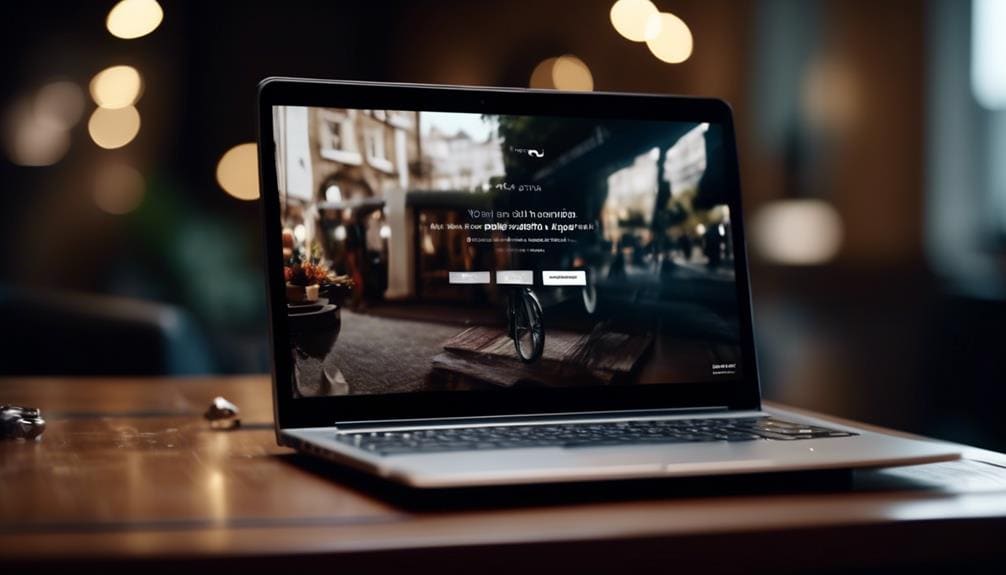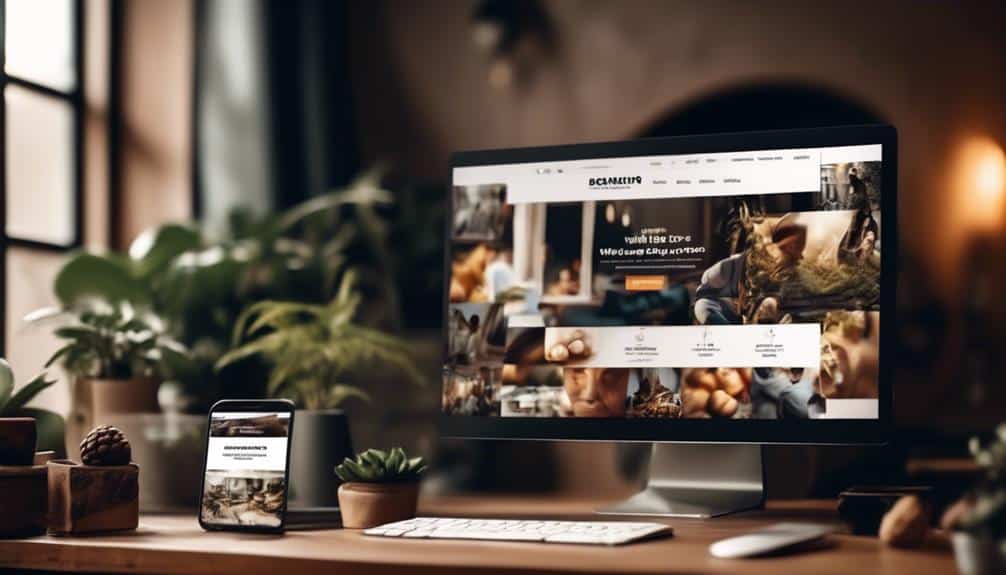Exclusive Insights: Master the Art of Irresistible Email Pop-Ups Before Your Competitors
Want to stay ahead of the competition when it comes to email marketing? Mastering the art of irresistible email pop-ups is the key to capturing your audience's attention and driving conversions.
But where do you start? In this exclusive insight, you'll discover the essential strategies and techniques to create email pop-ups that are simply irresistible.
From understanding your target audience to crafting compelling copy and designing eye-catching templates, we'll guide you through the process step by step.
So, if you're ready to take your email marketing to the next level, keep reading to uncover the secrets of mastering email pop-ups before your competitors do.
Key Takeaways
- Understanding your target audience is crucial for creating effective email pop-ups. Analyze demographics and behavioral patterns to personalize offers and tailor pop-ups accordingly.
- Design eye-catching pop-up templates by using bold colors, engaging visuals, and clear call-to-actions. Optimize templates for mobile viewing and stay updated with pop-up design trends.
- Implement effective call-to-actions that motivate the audience to take action. Use compelling language, clearly communicate the value of the offer, and optimize for mobile devices to drive conversions and captivate the audience.
- Testing and optimization are essential for maximizing the effectiveness of email pop-ups. Conduct A/B testing to identify what resonates best with the audience, make data-driven decisions, and continuously fine-tune pop-ups for better results. Also, measure and analyze conversion rate, bounce rate, engagement metrics, and continuously improve pop-up strategies based on insights and testing.
Benefits of Email Pop-Ups

Discover the untapped potential of email pop-ups and unlock a world of benefits for your online business. By incorporating email pop-ups into your website, you have the opportunity to improve conversions and increase engagement like never before.
One of the main benefits of email pop-ups is their ability to improve conversions. With a well-crafted pop-up, you can capture the attention of your website visitors and entice them to take action. Whether it's signing up for your newsletter, making a purchase, or downloading a free resource, email pop-ups provide a powerful tool for driving conversions.
Furthermore, email pop-ups are an effective way to increase engagement with your audience. By collecting email addresses, you can establish a direct line of communication and build a relationship with your customers. Through personalized email campaigns, you can keep your audience informed, offer exclusive promotions, and nurture leads. This increased engagement can lead to higher customer loyalty and repeat business.
Understanding Your Target Audience
To effectively master email pop-ups, you need to understand your target audience inside out. This means delving into their demographics, such as age, location, and gender, to tailor your pop-ups accordingly.
You also need to analyze their behavioral patterns, like browsing habits and purchase history, to deliver relevant and timely messages.
Lastly, identifying their pain points will allow you to create compelling offers that address their specific needs and desires.
Audience Demographics
Understanding your target audience is crucial for effective email pop-up strategies. By analyzing audience demographics, you can tailor your pop-ups to resonate with your customers' specific needs and preferences.
Here are four key factors to consider when segmenting your audience:
- Age: Different age groups have distinct interests and behaviors. Customize your pop-ups to appeal to the preferences of each age segment.
- Gender: Men and women often have different purchasing patterns. Use gender-specific language and imagery to target your pop-ups accordingly.
- Location: Geographical location plays a role in consumer behavior. Consider localizing your pop-ups to address regional interests and concerns.
- Interests: Understanding your audience's hobbies, preferences, and values allows you to create personalized offers that are more likely to convert.
Behavioral Patterns
By analyzing the behavioral patterns of your target audience, you can gain valuable insights that will help you tailor your email pop-ups to effectively engage and convert potential customers.
Understanding the motivations and psychological triggers that drive your audience's actions is key to creating irresistible email pop-ups that capture their attention and drive them to take action.
By studying their browsing habits, purchase history, and interactions with your website, you can identify patterns that reveal what motivates them to engage with your brand. Are they seeking discounts, exclusive content, or personalized recommendations?
By understanding these motivations, you can create email pop-ups that speak directly to their needs and desires, increasing the likelihood of conversion and building a stronger relationship with your audience.
Pain Points
As you dive deeper into understanding your target audience, it becomes crucial to identify their pain points in order to create effective email pop-ups. By understanding what your audience struggles with, you can tailor your messaging and offers to provide solutions that resonate with them.
Here are four common pain points to consider:
- Low customer retention: Identify why customers are leaving and address those issues in your email pop-ups. Offer incentives or exclusive content to encourage them to stay.
- Low conversion rates: Figure out why visitors aren't converting into customers. Use persuasive language and compelling offers in your pop-ups to increase conversion rates.
- Lack of personalization: People want to feel special and valued. Use data to personalize your pop-ups and make them more relevant to each individual.
- Information overload: Simplify your pop-ups and focus on the most important message. Clarity and simplicity will help capture your audience's attention.
Crafting Compelling Email Copy
Craft captivating email content that engages readers and compels them to take action. In today's digital landscape, where attention spans are short and competition is fierce, crafting compelling email copy is essential to stand out from the crowd. By leveraging effective email marketing strategies and incorporating psychological triggers in your email copy, you can create irresistible content that drives conversions and drives your business forward.
To help you craft compelling email copy, here is a handy table outlining three key psychological triggers and how you can incorporate them into your emails:
| Psychological Trigger | How to Incorporate |
|---|---|
| Fear of Missing Out | Create a sense of urgency by highlighting limited-time offers or exclusive deals. Use phrases like "Limited stock available" or "Offer ends soon" to encourage immediate action. |
| Social Proof | Showcase customer testimonials or user-generated content to establish trust and credibility. Include phrases like "Join thousands of satisfied customers" or "See what others are saying about us" to validate your offering. |
| Personalization | Tailor your email copy to each recipient by using their name or referencing their previous interactions with your brand. This personalized approach makes the reader feel valued and increases engagement. |
Designing Eye-Catching Pop-Up Templates

To continue captivating your audience and driving conversions, let's now explore the art of designing eye-catching pop-up templates. In today's fast-paced digital world, it's crucial to stay up-to-date with the latest pop-up design trends to maximize your conversion rates.
Here are four key elements to consider when creating your irresistible pop-up templates:
- Bold and Vibrant Colors: Use eye-catching colors that grab attention and evoke emotions. Bright and contrasting hues can help your pop-up stand out and make a lasting impression.
- Engaging Visuals: Incorporate visually appealing images or graphics that align with your brand and message. High-quality visuals can instantly capture your audience's interest and encourage them to take action.
- Clear and Compelling Call-to-Action: Craft a concise and persuasive call-to-action that clearly communicates the value of your offer. Use action verbs and compelling language to motivate your audience to act immediately.
- Mobile-Friendly Design: With the majority of internet users accessing content on their mobile devices, it's essential to optimize your pop-up templates for mobile viewing. Ensure that your pop-ups are responsive and easy to interact with on smaller screens.
Implementing Effective Call-to-Actions
Captivate your audience and drive conversions with compelling call-to-actions that motivate immediate action. Implementing effective call-to-actions is crucial for optimizing your email pop-ups and increasing your conversion rates. A well-crafted call-to-action can not only entice your audience to take the desired action but also improve the overall user experience.
To help you create irresistible call-to-actions, here are three key elements to consider:
| Element | Description | Example |
|---|---|---|
| Clarity | Clearly state what action you want the user to take. | "Sign up now for exclusive access!" |
| Urgency | Create a sense of urgency to prompt immediate action. | "Limited time offer – act fast!" |
| Benefit | Highlight the value or benefit the user will receive by taking action. | "Get 10% off your first purchase today!" |
Timing and Frequency of Pop-Ups

Timing and frequency play a crucial role in optimizing the effectiveness of your email pop-ups and maximizing conversion rates. To ensure that your pop-ups are seen at the right time and in the right frequency, consider the following strategies:
- Exit-intent pop-ups: These pop-ups appear when a visitor is about to leave your website, grabbing their attention just before they exit. This timing strategy allows you to capture their interest and potentially convert them into subscribers or customers.
- Time-delayed pop-ups: By setting a specific time delay, you can schedule pop-ups to appear after a certain period of time spent on your website. This strategy ensures that visitors have had enough time to explore your content before being presented with an email opt-in opportunity.
- Scroll-triggered pop-ups: These pop-ups are triggered when a visitor scrolls to a certain point on your page. By using this strategy, you can engage visitors who've shown a level of interest by actively scrolling through your content.
- Balancing pop-up frequency: While pop-ups can be effective, bombarding visitors with too many can be annoying and counterproductive. It's important to strike a balance and limit the frequency of pop-ups to avoid overwhelming your audience.
A/B Testing for Optimization
Ready to take your email pop-ups to the next level?
A/B testing is the key to unlocking optimization and improving your conversion rates.
By testing different designs and layouts, you'll be able to identify what resonates best with your audience and make data-driven decisions to maximize your results.
Get ready to fine-tune your pop-ups and see your email list grow like never before.
Testing Email Pop-Up Designs
To optimize your email pop-up designs, conduct A/B testing to determine the most effective design for capturing your audience's attention. A/B testing allows you to compare different versions of your email pop-up and analyze which one performs better.
Here are four key elements to consider when testing your email pop-up designs:
- Designing Elements: Experiment with different colors, fonts, images, and layouts to find the combination that resonates best with your audience.
- User Experience: Test different placement options, such as top of the page, sidebar, or exit-intent pop-ups, to see which one generates the highest engagement.
- Call-to-Action: Vary the wording, size, and placement of your call-to-action button to optimize the conversion rate.
- Timing and Triggers: Test different time delays, entry points, or exit triggers to find the most effective moment to display your pop-up.
Optimizing Conversion Rates
To optimize your conversion rates, conduct A/B testing and optimize your email pop-up design based on the results.
A/B testing allows you to compare two different versions of your email pop-up to determine which one performs better in terms of conversion.
By testing different elements such as the headline, call-to-action, color scheme, or placement, you can identify the most effective design that resonates with your audience and compels them to take action.
This conversion optimization process is crucial for maximizing the success of your email marketing strategies.
Remember to track and analyze the data from your A/B tests to make informed decisions about your email pop-up design.
Stay ahead of your competitors by continuously refining and improving your email pop-up strategy to drive higher conversion rates.
Integrating Pop-Ups With Your Website

Integrate pop-ups seamlessly into your website to captivate and engage your audience effortlessly. By incorporating pop-ups strategically, you can enhance the user experience and increase conversion rates.
Here are four key considerations to help you master the art of integrating pop-ups with your website:
- Customization options: Personalization is key. Customize your pop-ups to match your website's branding and design. Tailor the messaging to resonate with your target audience and align with their interests and needs. By offering a personalized experience, you can make your pop-ups more compelling and relevant.
- Integration challenges: Ensure that your pop-ups are compatible with your website platform and other marketing tools. Consider the technical aspects, such as responsive design and loading speed, to ensure a smooth integration. Address any potential conflicts or compatibility issues early on to avoid disruptions to your website's functionality.
- Placement and timing: Strategic placement and timing are crucial for the success of your pop-ups. Experiment with different positions and triggers to find what works best for your audience. Consider using exit-intent pop-ups to re-engage visitors who are about to leave your site, or use timed pop-ups to capture attention after a certain period of engagement.
- A/B testing: Continuously test and optimize your pop-ups to maximize their effectiveness. Experiment with different designs, copy, and offers to see what resonates best with your audience. Use analytics and data to track the performance of your pop-ups and make data-driven decisions to improve conversion rates.
Personalization Strategies for Higher Engagement
As you continue to enhance the integration of pop-ups with your website, it's time to explore the power of personalization strategies for higher engagement.
Personalization techniques can take your email pop-ups to the next level, capturing the attention of your audience and increasing their engagement with your brand.
One effective personalization technique is customer segmentation. By dividing your audience into specific groups based on their demographics, behavior, or preferences, you can tailor your pop-ups to their individual needs and interests. For example, if you have an online clothing store, you can create different pop-ups for men and women, showcasing products that are more relevant to each group.
Another personalization technique is using dynamic content. With dynamic content, you can customize your pop-ups based on the information you have about your visitors. For instance, if a visitor has previously purchased a specific product, you can show them a pop-up offering related products or accessories.
Personalization strategies not only make your pop-ups more relevant to your audience but also show that you value their individuality. By providing them with personalized offers, recommendations, or exclusive discounts, you can create a sense of exclusivity and build stronger connections with your customers.
Incorporating personalization techniques into your email pop-ups won't only increase engagement but also improve the overall user experience. Take the time to analyze your audience, gather relevant data, and implement personalized pop-ups that will captivate and convert your visitors.
Stay ahead of your competitors by mastering the art of irresistible, personalized email pop-ups.
Analyzing and Measuring Pop-Up Performance

Begin by analyzing and measuring the performance of your email pop-ups to gain valuable insights and optimize your strategies for maximum effectiveness. Tracking analytics and measuring effectiveness are crucial steps in understanding how your pop-ups are performing and identifying areas for improvement.
Here are four key aspects to consider when analyzing and measuring the performance of your email pop-ups:
- Conversion Rate: Measure the percentage of visitors who interact with your pop-up and take the desired action, such as subscribing to your email list or making a purchase. A higher conversion rate indicates a more effective pop-up.
- Bounce Rate: Keep an eye on the number of visitors who leave your website immediately after seeing the pop-up. A high bounce rate suggests that your pop-up might be intrusive or irrelevant to your audience.
- Engagement Metrics: Look at metrics like click-through rate and time spent on page to understand how engaged your audience is with your pop-up. Higher engagement indicates that your pop-up is capturing attention and driving interest.
- A/B Testing: Experiment with different variations of your pop-up design, copy, and offers to see which combination performs best. A/B testing allows you to make data-driven decisions and continuously improve the effectiveness of your pop-ups.
Frequently Asked Questions
How Can I Customize the Appearance of My Email Pop-Up Templates to Match the Branding of My Website?
You can customize the appearance of your email pop-up templates to match your website's branding by using these email pop-up design tips. Create a cohesive and visually appealing experience for your audience.
Are There Any Specific Guidelines or Best Practices for Determining the Optimal Timing and Frequency of Email Pop-Ups?
To strike the right balance between engagement and annoyance, leverage consumer behavior for maximum impact. Consider the psychology behind timing and frequency of email pop-ups. Find the sweet spot that keeps your audience engaged without overwhelming them.
What Are Some Common Mistakes to Avoid When Crafting Email Copy for Pop-Ups?
When crafting email copy for pop-ups, avoid common mistakes like using generic language or overwhelming the reader. Instead, use effective strategies such as personalization, compelling headlines, and clear calls to action to create irresistible and engaging emails.
How Can I Effectively Measure the Performance of My Email Pop-Ups and Track Their Impact on My Website's Conversions?
You can effectively measure the performance of your email pop-ups and track their impact on your website's conversions by utilizing tracking metrics and analyzing conversion rates. Take control of your success today!
Are There Any Legal Considerations or Regulations That I Should Be Aware of When Implementing Email Pop-Ups on My Website?
When implementing email pop-ups on your website, it's crucial to consider legal regulations and ensure GDPR compliance. Stay ahead of the game by being aware of the legal considerations and taking the necessary steps to protect your customers' data.
Conclusion
Mastering the art of irresistible email pop-ups is crucial for staying ahead of your competitors.
By understanding your target audience, crafting compelling email copy, and designing eye-catching templates, you can create pop-ups that engage and convert visitors.
Implementing effective call-to-actions, conducting A/B testing, and integrating pop-ups with your website further optimize their performance.
Don't forget to personalize your pop-ups for higher engagement and analyze their performance to continuously improve.
With these strategies, you'll be able to create email pop-ups that are impossible to resist.







